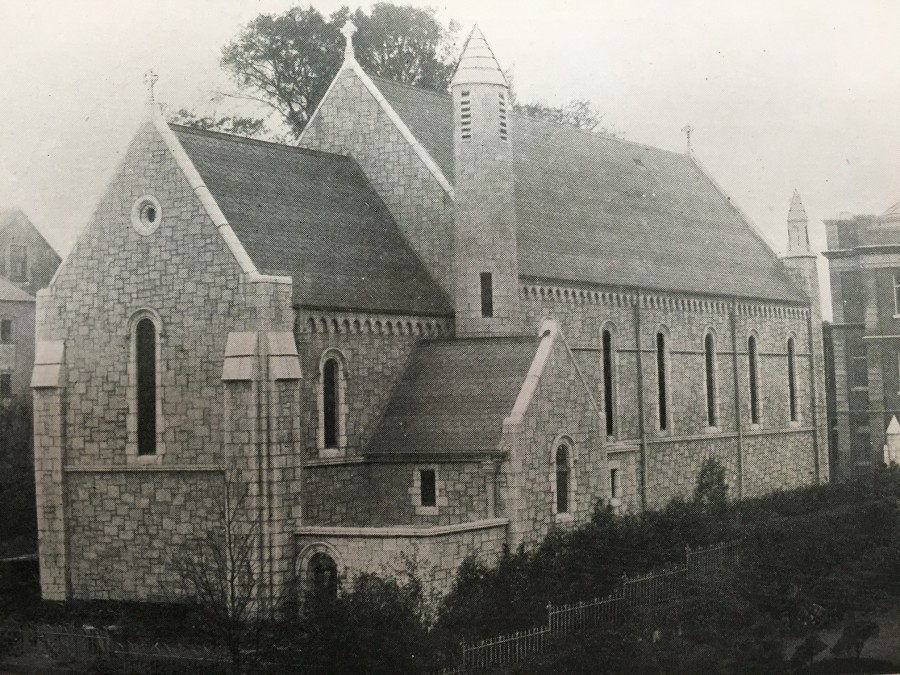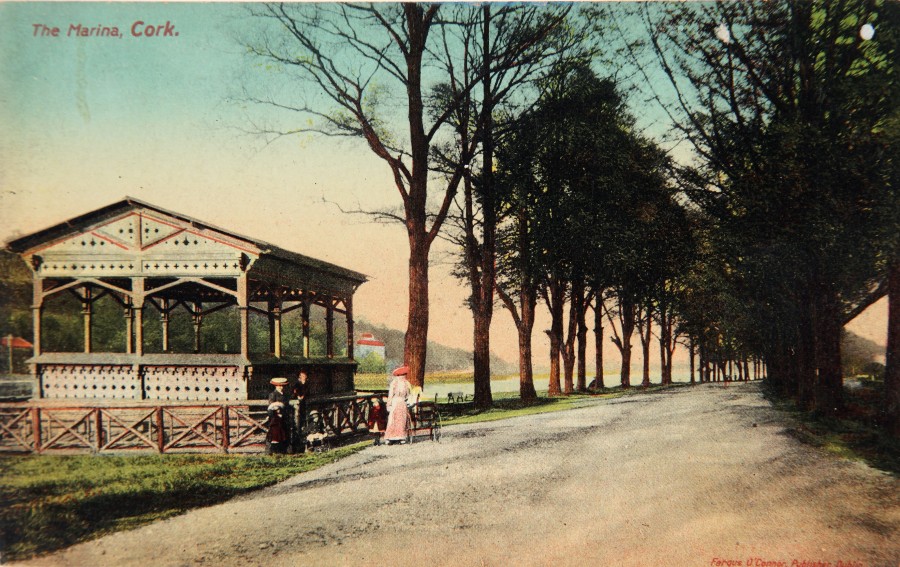
Kieran’s Our City, Our Town Article
Cork Independent, 24 November 2016
Remembering 1916: A Proposal from Southport
The agenda of the special meeting of Cork Corporation held on 22 November 1916, this week one hundred years ago, was about revolutionising industry in Cork City and the region. Standing orders were suspended in order to consider a certain proposal from Mr R Woodhead of 91 Lord Street, Southport. The pitch was made on behalf of undisclosed principles with the aim of purchasing a portion of the freehold of Cork Park Racecourse. The building site was to be on the Marina, and also sought to take a portion of the public roadway on the Marina, and a portion of the public roadway on Victoria quay, at a price of £10,000. In essence this was a historic meeting as the City Councillors began their discussion of Mr Woodhead’s proposal who was working on behalf of the Ford Motor Company and their attempts to create a branch of their world wide industry in Cork.
Earlier in 1916, the original discussion paper presented by Mr Woodhead to Cork Corporation and the Cork Industrial Development Association involved the northern and southern banks of the River Lee, just east of the Port of Cork Building and Custom House structures. The initial idea was to build a factory on one or the other sides of the river to employ 2,000 adult males. On the northern side of the river for half a mile there extended the yards of the Cork Harbour Commissioners. These were formerly the site of shipbuilding yards conducted by the Pike family in the early nineteenth century. On the southern bank it was pitched to utilise a portion of Cork Park Racecourse to build an industrial village for the Ford plant workers. The idea of industrial housing was present en mass in Britain and Ireland. Two firms were mentioned as examples in the Council debate, both of whom, provided workers’ housing – Messrs Bradbury and the Lever Brothers.
Bradbury of Wellington Works in Oldham in Greater Manchester was the birthplace of the sewing machine industry and made clones of Singer sewing machines. Circa 1910 they extended their business into the manufacture of light weight motorcycles. Lever Brothers were one of several British companies that took an interest in the welfare of its employees. The model village of Port Sunlight in Merseyside was developed between 1888 and 1914 adjoining their soap factory to accommodate the company’s staff in good quality housing, with high architectural standards and many community facilities. Between 1889 and 1914, 800 houses were built to house a population of 3,500. William Lever introduced welfare schemes and provided for the education and entertainment of his workforce, encouraging recreation and organisations, which promoted art, literature, science or music. In the Cork context, in the early twentieth century many farm labourers needed housing. In 1906, Cork County Council agreed to build four such groups named model villages at Bishopstown, Clogheen, Dripsey and Tower.
With the Cork Ford plant project, the impact on diminishing poverty and employment at an enormous rate was not underestimated. The city’s traditional industries such as butter export had been in decline for some years. Media reports in the Cork Examiner throughout the year 1916 noted the continuous and slow demise of the Cork Butter Market. Large supplies of fresh butter were in excess. Danish butter was much lower in price and unsalted French butter together with big arrivals from New Zealand, Argentina and Australia out competed the Cork Market.
For the new Cork Ford plant, the media calculated an eight hour day at a shilling an hour, which would equate to each man’s wages amounting to £2 8s 0d per week. The total earned by 2,000 workers would amount to £4,800 per week, or roughly £250,000 per annum. It was projected that the effect of the expenditure of such a sum spent amongst the traders and shopkeepers of Cork would make the city in a few short years one of the most prosperous and progressive centres in Ireland, and the standard of living would be vastly improved amongst all classes. Other municipalities in Ireland were more than willing to place suitable sites at the disposal of Fords whom Mr Woodhead represented. All agreed not to impose rates on the factory if they could secure the establishment of such a gigantic industry within their jurisdiction. However Cork had been selected by Fords on account of the broad waterway it possessed and they hoped to create a business in the city on even a larger scale than they had been doing at Manchester.
An assembly plant in Trafford Park in Manchester opened in 1911 (closed in 1946) employing 60 people to make the Model T Ford. In the wider park 12,000 workers were employed making it one of the most significant engineering facilities in Britain. It was the first Ford Factory outside of North America. Six thousand cars were produced in 1913 – a doubling of output within a year and the Model T became the country’s biggest selling car with 30 per cent of the market. After the First World War, the Trafford Park Plant was extended, and in 1919, 41 per cent of British registered cars were Fords. By 1924 the plant had reached its limits and a new factory was opened in Dagenham in 1931. The plant was served by the Manchester Ship Canal, which had opened in 1894, to make Manchester the third busiest port in Britain despite being about 64 kilometres inland.
Cork 1916, A Year Examined (2016) by Kieran McCarthy & Suzanne Kirwan is now available in Cork bookshops.
Cork City History Tour (2016) by Kieran McCarthy is also available in Cork bookshops.
Historical Walking Tour of Blackrock with Kieran, Sunday 27 November, 2.30pm. meet at Blackrock Castle (free: two hours)
Captions:
871a. The Marina Walk, c.1910 (source: Cork City Through Time by Kieran McCarthy & Dan Breen)
871b. St Patrick’s Quay, c.1910 (source: Cork City Through Time)
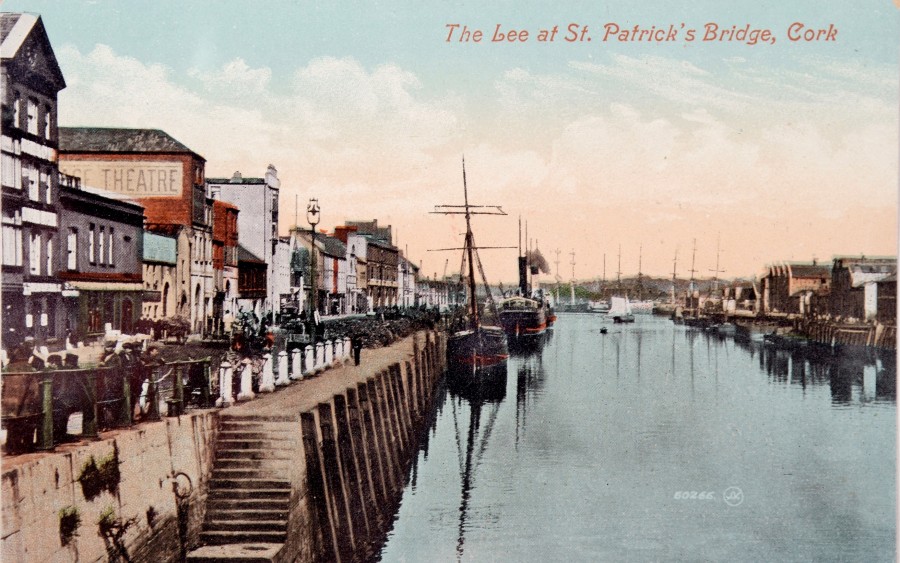
As a contribution to marking the restoration of the tram lines as a heritage feature in Blackrock Cllr Kieran McCarthy will conduct a historical walking tour of Blackrock Village on Sunday 27 November, 2.30pm (starts at Blackrock Castle, two hours, free). Cllr McCarthy notes: “A stroll in Blackrock is popular by many people, local and Cork people. The area is particularly characterised by beautiful architecture, historic landscapes and imposing late Georgian and early twentieth century country cottages to the impressive St Michael’s Church; every structure points to a key era in Cork’s development. Blackrock is also lucky that many of its former residents have left archives, census records, diaries, old maps and insights into how the area developed, giving an insight into ways of life, ideas and ambitions in the past, some of which can help us in the present day in understanding Blackrock’s identity going forward”.
One hundred years ago, the Corporation of Cork had to foresight to connect the city’s suburbs with the city centre through a tram network. The story of how the trams connected the old fishing village of Blackrock with the city is a worthy one to tell- connected in terms of the wealth of history in this corner of the city and connected in terms of experimenting with the provision of new transport networks. The trams were developed in connection with the Corporation’s roll-out of electricity in the city in 1898. The tram lines themselves were electricity cables. The Corporation of Cork established a large electricity generating plant on Albert Road (now the site of the National Sculpture Factory). The Electric Tramways and Lighting Company Ltd was registered in London and had a close working relationship with eminent electrical contractors, the British Thomson-Houston Company. Cllr McCarthy highlights: “By 1900, 35 electric tram cars operated throughout the city and suburbs. They were manufactured in Loughborough, UK and all were double deck in nature, open upstairs with a single-truck design”. Cllr McCarthy’s walk will finish at Natural Foods Bakery at 4.30pm in time for tea, coffee and poetry to mark the restoration of the old tram lines with Douglas Writers club.
Independent Cork City Councillor Kieran McCarthy welcomes the President of the EU Committee of the Regions, Mr Markku Markula, to Cork this Saturday 19 November to showcase the innovation hubs of Cork city and region and to host him at a Cork City debate on the role of small cities and towns within the EU. Mr Markula also accepted the invite of Cllr McCarthy and Cork Innovates to speak at the Global Start Up Nations event taking place at Cork County Hall this weekend.
In a recent debate on the future of the EU in the EU Committee of the Regions Mr Markula’s noted of the importance of listening to EU citizens: “citizens should have an inclusive, smarter, and safer Europe. We should channel politically our citizens’ critical assessment on the EU and its added value on the ground, but also their ideas for its better functioning and delivering. One way we could listen more to our communities’ concerns about Europe, for instance is through citizens’ dialogues or town hall debates”. Cllr McCarthy on hearing his call for action has invited Mr Markula and his team to Cork to such a city debate to listen to the concerns of a small EU city and region. Cllr McCarthy, a member of the EU Committee of the Regions, noted: “Cork is pursuing much work in the realms of start-ups and innovation and wishes to scale up within the EU. I have concerns that small cities such as Cork – small cities are plentiful within the EU – could be forgotten about in future cohesion policy debates. Cities and regions such as Cork have huge heart, passion, and energy to contribute positively to the bigger EU tapestry of policy making especially in evolving business, enterprise, employment and social policy models. Mr Markula will debate with Mr Dara Murphy TD, Minister for European Affairs at 2pm (duration: 1 hour), Saturday 19 November at the Gateway Building, UCC. The event is free but for registration, please email sarah.holden@iro.ie.
Thanks Lord Mayor.
I would like to thank the CE and John Hallihan for their work on this draft document and the Chair of the Finance Functional Committee, Sean Martin for agreeing to long discursive evenings around savings, cuts and compromises.
One would like to think we we’re at the bottom of barrel of large scale cuts –I feel we are – however this base is very different to previous years where there were easier choices of cuts – now the landscape at the base is scraping the barrel looking for anything else we can use to balance our books.
It is quite clear that local Government not taken seriously enough by central government– the daily local government email updates offer an interesting lens at the moment to see other Councils across the country desperately trying to make ends meet on budget night.
The Putting People First project has equalled cutting people first.
It is becoming more and more clear LPT for cities such as Cork are not enough to fund Councils and their work – even if you put it up by 15 per cent. It’s not enough.
Our revenue reserves are scarily exhausted, our patience is exhausted and we are physically and mentally exhausted and frustrated.
For next year we can add another piece of Roads to the central government agenda– the maintenance programme as being dictated upon – piece by piece, the discretion decisions of cllrs has been eroded.
Is anyone fighting the case for local government in Dail Eireann? nope not really
And one could go on and on with reality and negativity and one could be right.
Positivity:
I am reminded as well we also need to be positive on what services we do provide.
On the positive side though reading the draft budget book, the dearth of services we provide to communities in Cork is vast.
Continued emphasis on the turn around of vacant social housing units and their return to stock is very welcome. We continue to collaborate with agencies to resolve our homelessness problems.
We continue to provide support to those aspects of building community capacity through community grants – we collaborate with agencies on community policing plans, public participation networks, Age friendly programmes, the local economic and community development plan – it is a council for all.
We do festivals well – we have seen the recent buzz this year around 1916 events, Jazz festival, and the switch-on of the Christmas lights.
We have struck very good partnerships in creating local enterprise partnerships, arts and heritage programmes, promoting science and technology; we are fully engaged in Lifelong Learning, encouraging formal and informal education. We invest 1m euros in visitors centre, events and community and arts grants.
And indeed one could say all we do well of what I have listed doesn’t really stay on the agenda as regular points – they only all appear together in draft budget books like this evening – it’s kinda like everything we do is diluted down to just housing and roads – and that is something we need to avoid – the Council is more than just two directorates.
From looking at some of the conclusions in the draft book – there are number of points sticking out – need for continued collaboration need with CBA and Cork Chamber going forward – the need to market even more business and enterprise in the city – would love to see the South Mall as a start-up incubation street. We need to promote parking in the city more – and build an alternative marketing plan to the shopping centres.
We need to build upon our tourism offering and festivals – scale two or three of them up to international standards – 30 odd festivals, which celebrate the city’s urbanity and cultural thinking
Tonight has also historical resonances or a sense of Déjà vu as well – this week one hundred years ago – city cllrs spoke at length about poverty in their Council meeting about poverty in the city and declining industry – but Trafford Engineering Co of Manchester – came to discuss their proposals for a tractor factory in what is our North Docklands and a worker’s village upon the city park racecourse to employ 2,000 adult males with a wage bill of £200,000. The cllrs of course heralded this proposal and led to its tweaking – the factory to be upon the Marina – worker’s housing never came to pass.
Cllrs heaped praise on the project – the value of it to communities, local economic development, business communities, social policy, enterprise, poverty reduction – but they couldn’t have foreseen the vast opportunities and scalability within all those concepts, all of which Fords wove together to re-imagine an ancient port city.
Fast forward to today I do think the value element and the interweaving of different elements is one we need to champion more as Ireland’s second city.
Thank you.

Kieran’s Our City, Our Town Article,
Cork Independent, 17 November 2016
Remembering 1916: An Ornament to Cork
The opening event of the Honan Chapel on 5 November 1916 was marked with great speeches and insights into the work involved in its construction from the funders to the craftsmen. There are so many beautiful features of the Honan Chapel and UCC over the years have published articles, online resources and a book edited by Virginia Teehan and Elizabeth Wincott Heckett, and held conferences on the beautiful building. Indeed, the next conference is on this Saturday 19 November in UCC (details at end of column).
The Honan Chapel is a national icon of Irish craftsmanship, some features of which I relate below and all warrant articles and multiple column inches in years to come. The erection of the chapel was entrusted to the well-known building firm of Messrs John Sisk and Son. The work was carried out under the superintendence of Mr Peter O’Flynn as Clerk of Works. John Sisk set up his construction business in 1859 and by the early twentieth century had an impressive record of work around the province of Munster, building schools, hotels, banks and 30 churches.
An open letter on 30 May 1916 in the Cork Examiner by the members of the Cork branch of Stonecutters’ Union of Ireland, recorded their appreciation to Sir John O’Connell for providing much needed employment to their members for close on two years and a much-needed stimulus to the stone cutting industry. They noted their pride in the distinctive national style of architecture and its construction in Cork limestone and marble, which meant the circulation of such a large sum of money in Cork at a time of difficult economic conditions.
Cork Examiner reviews of the building on the 6 November point to the beauty of the interior and that it may strike the visitor as very simple but to execute the ornamentation “required painstaking care and skill and possession of the artistic faculty as well”. The carving was carried out by workmen under Henry Emery, an architectural sculptor and decorator. Liverpool born Henry Emery was active across the country from the 1870s until the 1930s and had his practice in Dublin. He was apprenticed initially to the stone and marble works of Alfred P Sharp of 17 Great Brunswick Street, Dublin. Sharp was also a builder. Circa 1877 Henry Emery was placed in charge of the stone and wood-carving side of the business. He was taken into partnership by Sharp in the late 1890s.
The Honan Chapel interior adopted the most decorative features in Cormac’s famous Chapel at Cashel in the arcading. Hence the walls were painted in a simple white with grey tints by artificial colouring. In each of the capitals of the pillars nearest to each stained glass window, on which a coat of arms of one of the diocese of Munster is displayed, part of the same coat of arms is carved. The most effective use of the arcading was to use it as a framework to a beautiful series of Stations of the Cross made of the inlaid art technique opus sectile. The altar was built of the same white limestone of which the rest of the fabric was built. The tabernacle was also of limestone modelled in the form of an early Celtic reliquary. The door bears a beautiful enamel by Mr Oswald Reeves.
The series of stained glass windows of the Munster Saints from the eminent studios of Harry Clarke and Sarah Purser begin on the north wall of the nave near the chancel with the window in honour of the Patron Saint of the Diocese – St Finbarr. Then it runs to St Albert, the Patron Saint of Cashel, St Declan of Ardmore, St Ailbe of Emly, St Fachtna of Ross and St Munchin of Limerick. The first window on the south side is devoted to St Ita of Killeedy, St Colman of Cloyne, St Brendan the Navigator, St Gobnait of Ballyvourney, St Carthage of Lismore and St Flannan of Killaloe. The east window over the Altar shows the Redeemer, while the three lights over the west entrance bear the three great Irish saints, Patrick, Brigid and Columcille.
The altar-plate, the vestments, altar coverings, everything down to the seating accommodation is not only Irish in design, but Irish in workmanship. As far as possible local craftsmanship were employed. The vestments for use in the chapel was made at Messrs William Egan and Son’s factory in Cork. The same firm made the chalice and ciborium, both exceptionally fine specimens of silver and gilt. As an interesting aside, on 21 January 1916 Mr Barry M Egan principal of the firm of William Egan and Sons passed away at his residence, Carrig House, Tivoli. Born in Cork seventy-three years previously, Mr Egan came from a family that for generations had been connected with the trade and art of working with metals. At the early age of 12 years he entered upon his apprenticeship as a watchmaker, jeweller, and silversmith in his father’s workshop. From his earliest years his ambition was to revive the manufacture of silver plate for which Cork was so noted in the eighteenth century.
Honan Chapel Symposium, Saturday 19 November, Aula Maxima, UCC, 9.15am-6pm, programme and registration at niamh.mundow@ucc.ie
Cork 1916, A Year Examined by Kieran McCarthy & Suzanne Kirwan is now available in Cork bookshops.
Captions:
870a. Honan Chapel, UCC, present day (picture: Kieran McCarthy)
870b. Section of mosaic of floor of chapel, entitled the River of Life (picture: Kieran McCarthy)
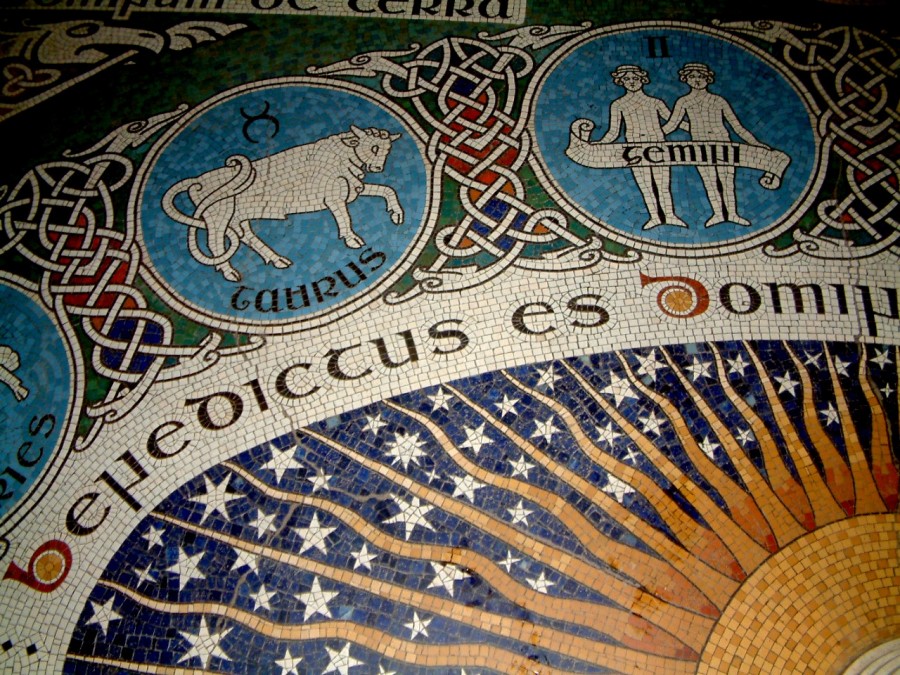
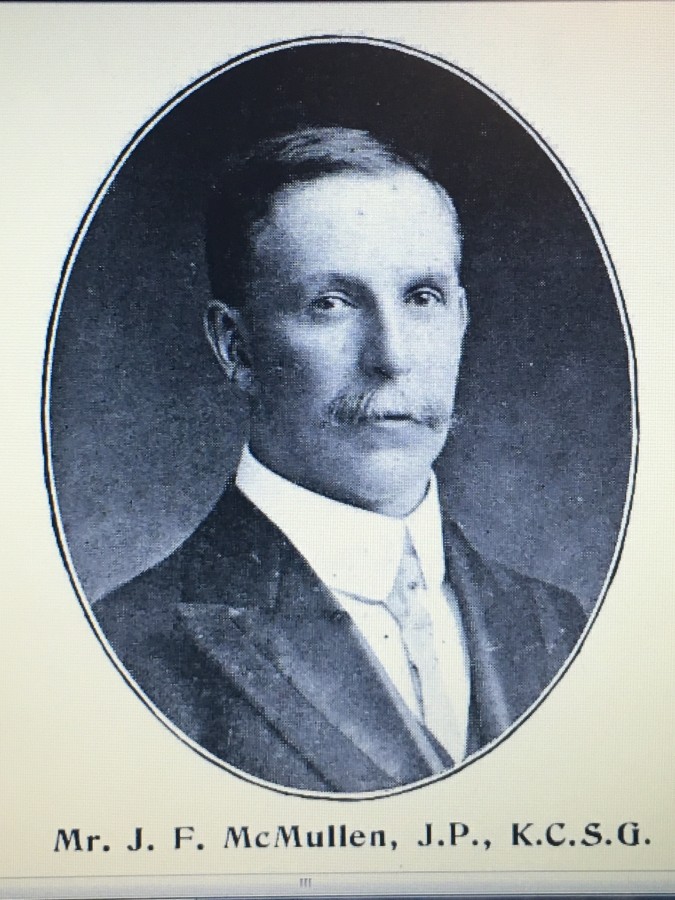
Kieran’s Our City, Our Town Article,
Cork Independent, 10 November 2016
Remembering 1916: McMullen’s Genius
The Honan Chapel celebrates its centenary this week. It opened officially on 5 November 1916. It is unique of its kind and John O’Connell, solicitor and distributor of Isabelle Honan’s will lavished much care as well as imagination on the church’s construction and fitting out (see last week’s column). John O’Connell was a great expert on ecclesiastical archaeology. He wrote many books and papers including “The Honan Hostel Chapel”, which can be read in local studies in Cork City Library. He also gave the site of the Turners Cross Schools in 1932 to Bishop Daniel Cohalan. He was also a descendent of Daniel O’Connell; hence the place name connections to Daniel O’Connell in Turners Cross.
On 18 May 1915, the foundation stone of the Honan Chapel was blessed and laid by the Bishop of Cork Dr Thomas Alphonsus O’Callaghan, and work progressed steadily on it. The new chapel was intended to be a real work of art. The architect James F McMullen planned a very beautiful structure in the Hiberno-Romanesque style, a style, which prevailed nine centuries previously. The Irish Architectural Archive in their Dictionary of Irish Architects denotes that architect and civil engineer James Finbarre McMullen (1859-1933) was born in 1859. He was the youngest son of Barry McMullen, a well-known Cork builder. After attending St Vincent’s School, James entered the arts faculty of Queen’s College, Cork, in 1875. At some stage he evidently decided to take up engineering as a career and served an apprenticeship with his elder brother Michael Joseph. In 1882 he exhibited a design entitled ‘What the Farm Labourers require’ at the Irish Exhibition of Arts & Manufactures, Dublin. He opened his own office in Cork c.1886.
James McMullen’s practice was a varied one, including ecclesiastical, hospital, industrial, commercial and domestic work, primarily in the city and county of Cork. He was architect to the South Infirmary, Cork, for some thirty years and was appointed local engineer and valuer for the Cork Junction Railway in 1904. Some of his largest and best known works apart from the Honan Chapel included Marina Flour Mills on Victoria Quay (1890-92), the Eye, Ear and Throat Hospital on Western Road (1895-97), the Fr Mathew Pavilion Museum at the Cork International Exhibition (1902), additions to the sanctuary for the Capuchin Fathers at Holy Trinity Church (1906) and the restoration after destruction by fire of Castle Freke House (with architect, Kaye-Parry & Ross) in 1910-12.
In addition to running a successful practice, James McMullen played an active part in the life of the community, devoting much time to city hospital work. Living in Trabeg in Douglas, he was appointed a magistrate for the borough of Cork in 1903 and High Sheriff in 1908. In 1910 the honour of Knight Commander of the Order of St Gregory the Great was conferred on him by Pope Pius X. According to his obituary in the Irish Builder, he acted as City Engineer for Cork for some years. He died in 1933, leaving an estate valued at £23,729. He had married Margaretta, daughter of J T Murphy, of Macroom, in 1907. His son James carried on the practice.
The Honan Chapel is based on the most famous Irish church of Hiberno Romaneque style that of Cormac’s Chapel on the Rock of Cashel. It was not the first Cork Chapel to adapt its design in the early twentieth century. St Finbarr’s Oratory in Gougane Barra, opened in 1902 and its architect Samuel Hynes was also inspired by Cormac’s Chapel. Cashel constitutes the most famous architectural assemblage to survive from Medieval Ireland. The entire summit of the Rock has a very complex mix of ideas about history, architecture, public space and meaning. The place is tied to a sacred history – the legend of St Patrick converting the Munster Gaelic kings of old. The information panels at Cormac’s Chapel detail that it was begun in 1127 and consecrated in 1134. At that time, Cormac’s Chapel was a political statement. The act of building it was a political act asserting identity. On the eve of Church reform, architecture became a form of dialogue of contestation. King Cormac MacCarthy, founder of the Chapel at Cashel, was a supporter and patron of the reform movement. The chapel was deemed a metaphor for his kingship, and religious interests and attached to influences of the renaissance in the way of life of the church.
The course of stone in Cormac’s Chapel was so correctly laid, that the joints escaped the eye so that it seems the whole wall is composed of a single block. The impact of such a church building was not seen before. Archaeologist Tadgh O’Keeffe in his book Romanesque Ireland, Architecture and Ideology in the Twelfth Century (2003) highlights that the architects of the Romanesque style were also occupied with great master-pieces. Sculptors and architects were moulded by European Art. The idea existed that Romanesque had form and meaning and thus became fashionable and sophisticated. Cormac’s Chapel as a memorial relied on the permanent qualities of architecture, scale, mass, spacing, proportion, utmost simplicity, and memory. These latter ideas also imbue the Honan Chapel and make it stand out as architectural structure of beauty.
Honan Chapel Symposium, Saturday 19 November, Aula Maxima, UCC, 9.15am-6pm, programme and registration at niamh.mundow@ucc.ie
Cork 1916, A Year Examined by Kieran McCarthy & Suzanne Kirwan is now available in Cork bookshops.
Captions:
869a. James F McMullen, architect of the Honan Chapel, UCC (source: Pike’s Contemporary Biographies)
869b. Interior of Cormac’s Chapel, Rock of Cashel, inspiration for Honan Chapel (picture: Kieran McCarthy)
896c. Honan Chapel, 1916 (source: J O’Connell, The Honan Hostel Chapel, 1916)
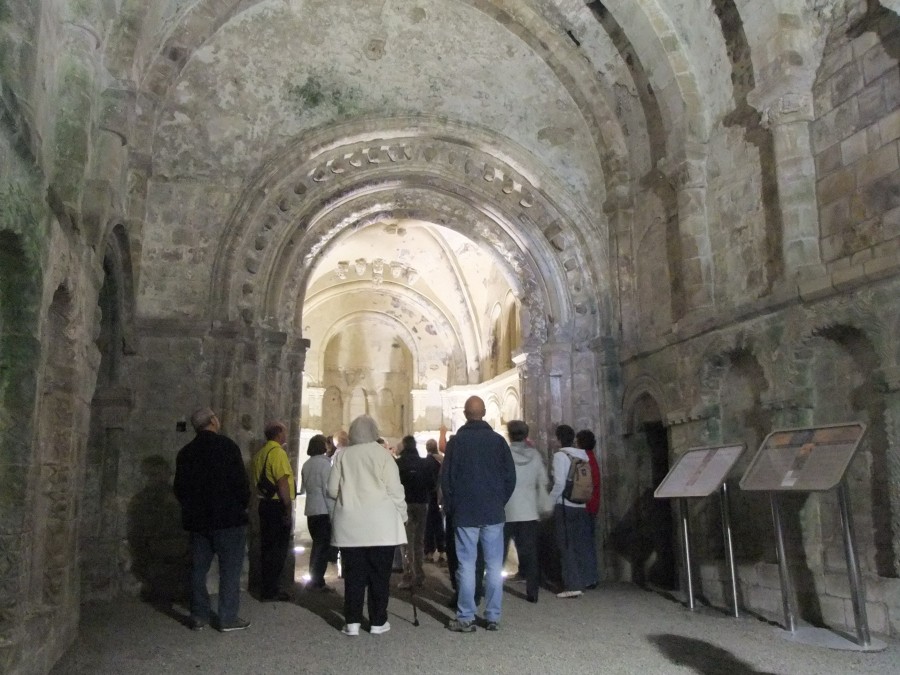
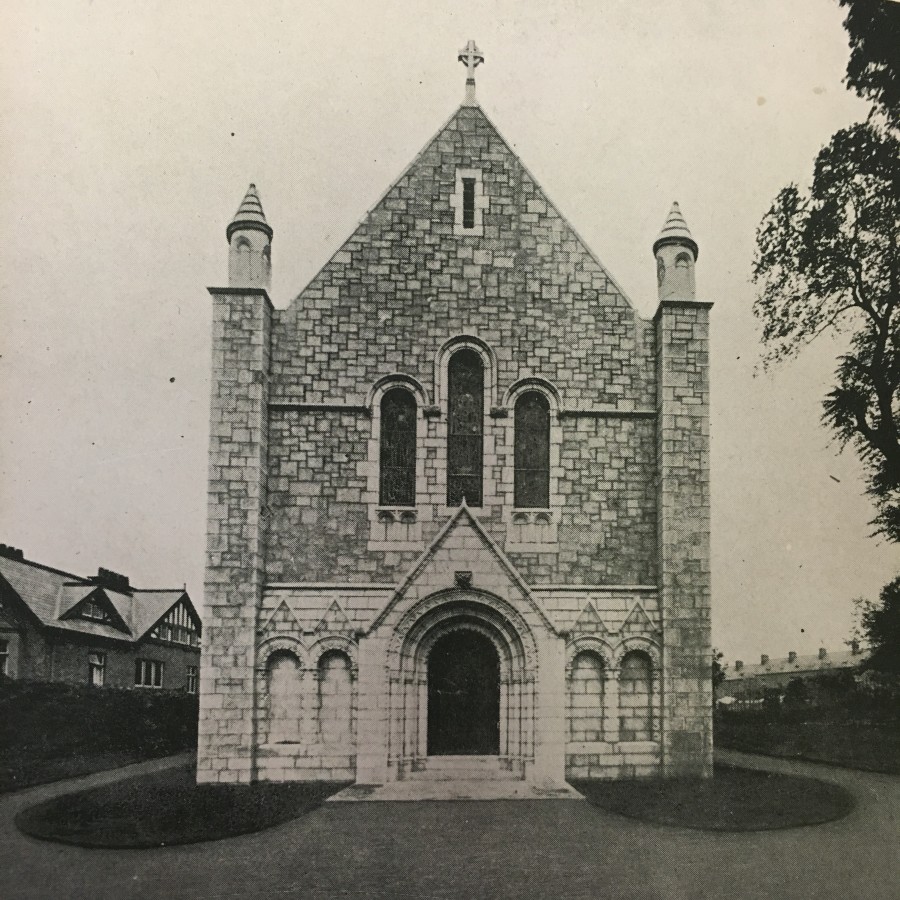
Always an amazing view, The Marina, Cork & gorgeous Autumnal landscapes
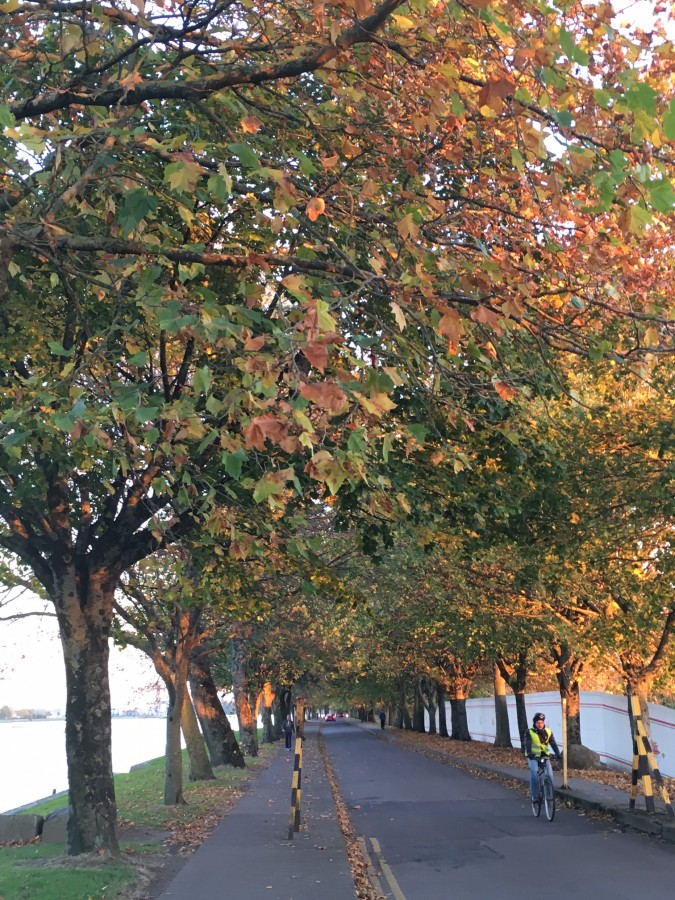
This week, a delegation from the Cologne-Cork Sister City committee visited Cork and were guided around the city with Cllr Kieran McCarthy as part of twinning activities with Cork. The 45 strong delegation arrived here on the Roald Amundsen tall ship from Cherbourg. It docked on the city’s quays for a number of days with support from the Port of Cork and Cork City Council. The tall ship is no stranger to Cork and is a training ship for those who wish to train in aspects of sailing. The tall ship, originally, named Vilm, is a German steel-ship built at the Elbe River in 1952. Having worked in different area, she was refitted in 1992 to 1993 as a brig – two masted square-rigged sailing ship, and now serves as sail training ship. During summer she usually operates in the Baltic Sea, and usually embarks for journeys to farther destinations for winter, including several-Atlantic crossings.
Cllr McCarthy on his walking tour outlined the history of the port, the harbour and the development of the city upon a set of estuarine marshes. He highlighted the history of Cork City Hall, streets such as the South Mall and St Patrick’s Street, and bringing them on top of the ramparts of Elizabeth Fort. During the tour, member of Cologne City Council discussed their interest in developing a twinning project for the upcoming 30th anniversary of the twinning. In previous years, Cork and Cologne have has success in school exchange programmes, council swop officer schemes and environment, artist and enterprise programmes.
Cllr McCarthy noted; “the twinning with Cologne has brought not just the title of twinning but connected Cork into the EU Continent. I am very impressed by the energy put into the twinning arrangement on the Cologne side. Interestingly both cities have aspects in common – for example the colours of Cork and Cologne are red and white; St Finbarre’s Cathedral was inspired by the beautiful Cologne Cathedral. As we approach the 30th anniversary in two years time, I think there is really great scope to secure more opportunities between the two cities. Every year, Cork City Council has a twinning grant schemes and there is scope within these schemes and outside these schemes for entrepreneurs, cultural creatives and sporting groups to explore possibilities and connections with North West Germany. Any ideas can be emailed to myself or written to the chair of the International Relations Committee.
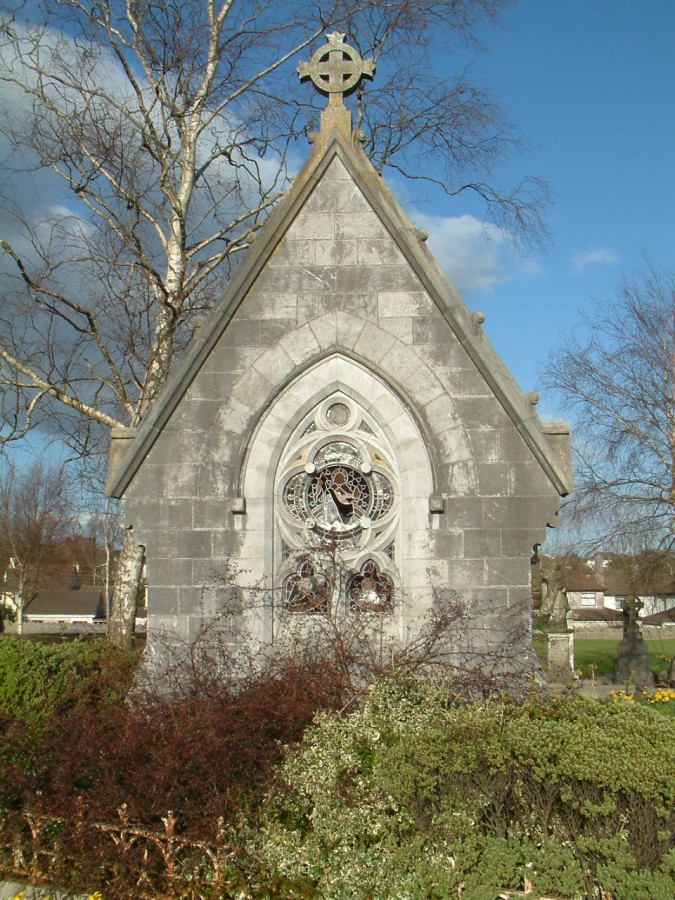
Kieran’s Our City, Our Town Article,
Cork Independent, 3 November 2016
Remembering 1916: Honan Chapel Celebrates its Centenary
One hundred years ago this week on 5 November 1916, the amazing architectural structure of St Finbarr’s Chapel at UCC or the Honan Chapel had its official opening. The Cork Examiner noted in its editorial the day after the opening the thought and work that went into planning its construction; “the provision of a chapel out of the Miss Isabella Honan Trust Fund was a happy thought on the part of Sir John O’Connell, her executor [of her will], who is himself a lover of Celtic art…it is only right to say that Sir John O’Connell took the utmost pains that everything in connection with the building of the chapel, materials, equipment, as well the carving and stained glass, should be the work of Irish artists”.
Isabella Honan of 26, Sidney Place, had died on 8 August 1913. Her obituary in the local newspapers recorded that she had belonged to an old Cork family, which had long been associated with charitable organisations in the city. The Honan Home (founded as a charitable trust in 1896 to host 12 aged and impoverished men) and the extension of St Patrick’s Church, were well known monuments of the religious and charitable zeal of her brother, Matthew Honan. Isabella herself had given £10,000 for scholarships to University College Cork. On her death, Isabella left a personal estate valued at £153,331 8s 5 ½ d. The distribution of her will was granted to John Robert O’Connell, of 24, Kildare Street, Dublin. Over 22 charitable organisations in Cork were allocated monies in her will ranging from £500 to £1,500. All were delighted with their funding and they sent several letters to editors of newspapers giving further insight into their work but also respect for the Honan Family. Trust funds representing the residue of her other brother’s Robert estate, totalling £40,000, were also granted to John O’Connell to distribute at his discretion to charitable purposes.
In an open public later to President Bertram Windle, UCC on the Cork Examiner on 6 April 1914, John O’Connell expressed concern that the Honan Hostel called St Anthony’s Hall, under the General Order of Friars Minor would sever their connection. The hostel was the house of residence for students at University College, Cork. It has been initially established in 1884 for Protestant students attending the college but began to house Catholics from 1909 onwards. John O’Connell in 1914 wrote about reconstituting it under new management; “it occurred to me that the reconstitution of this hostel, under a permanent Catholic Governing Body, would be of an immense benefit to the Church, and to the entire Catholic population of Munster, and one which would have been peculiarly pleasing to Miss Honan herself”. His idea was that the business side of the institution and the discipline of the students should be looked after by a warden, who for obvious reasons, should be a married man. He also noted that part of his scheme should be a proper chapel “suitable to the dignity of a university, with a chaplain resident in the Hostel, responsible for the spiritual welfare of its inmates, and provided for by endowment”. Bishop of Cork O’Callaghan agreed to John O’Connell’s requests for a governing body and a chapel.
As a further contribution, John O’Connell arranged to allocate to University College, Cork, a sum of £3,000 for the completion of a Biological Institute, dealing with the subjects of botany, agriculture, zoology, and geology. He was convinced that the training in agriculture afforded by UCC to the students of Munster would be rendered “more efficient and successful”. He also asked that St Anthony’s Hall should be called the Honan Hostel and that the Biological Institute in future should be known as “The Honan Biological Institute”.
John O’Connell was the driver of the Honan Bequests. In his obituary in the Cork Examiner on 29 December 1943, it was noted that he was born in Dublin on 12 February 1868, and was educated at Belvedere College and Trinity College, Dublin. He was admitted a solicitor (Ireland) in 1889 and was head of the firm of Thomas F O’Connell and son solicitors, Dublin. He was knighted in 1914 and in 1924 was made Commander of the Order of St Gregory the Great by Pope Pius XI. During his lifetime he was a member of the Senate of the University of Dublin, member of the Governing Body of UCC, a fellow of the Royal Society of Antiquities of Ireland and Vice President of the Incorporated Law Society of Ireland. In 1901 he married Miss Mary Scally of Dublin and following her death he sold his house at Killiney, Co Dublin, and spent some time with the Benedictine Monks. He decided to become a secular priest and was ordained for the Diocese of Westminster.
John O’Connell was a great expert on ecclesiastical archaeology. The Honan Chapel is unique of its kind and John lavished much care as well as imagination on its erection and fitting out. He wrote many books and papers including “The Honan Hostel Chapel”, which can be read in local studies in Cork City Library.
Honan Chapel Symposium, Saturday 19 November, Aula Maxima, UCC, 9.15am-6pm, programme and registration at niamh.mundow@ucc.ie
Cork 1916, A Year Examined by Kieran McCarthy & Suzanne Kirwan is now available in Cork bookshops.
Captions:
868a. Honan memorial, St. Finbarre’s Cemetery; the back stained glass window of the memorial needs to be urgently fixed (picture: Kieran McCarthy)
868b. Honan Chapel, 1916 (source: J O’Connell, The Honan Hostel Chapel, 1916)
